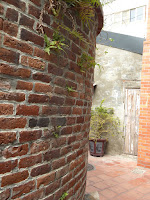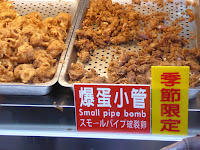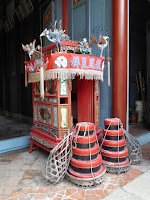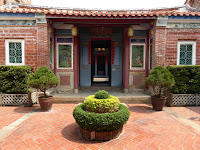 |
| Nine Turns Lane, Lukang |
Because Lukang largely wasn't redeveloped like most towns are, it still retains some of its old narrow lanes. One of these is Nine Turns Lane, which may not have exactly nine bends in it, but is certainly winding.
The lanes twist around because the homes were built alongside the winding stream, and obviously the pathways followed. But the weaving lane had its advantages too - not only did it make it harder for any invaders, but it also meant that the cold wintry winds didn't flow through, keeping the homes warmer.
Talking of invaders, the Ai gate here was built in 1830, so that they could close the gates at night as a defence against anyone attacking the town.
But Nine Turns Lane isn't the narrowest of lanes here, that honour goes to Touching Lane, so called not as an invitation, but because it was so narrow that two people going in opposite directions could not pass each other without touching. For that reason, it is said that a true gentleman will never walk down that lane.
 |
| Mock Weng walls, Lukang |
One of the places that we visited here was the Folk Museum, which was really quite good as an introduction to how people used to live, what their homes were like, and even some of the work related things like the tests they would have to pass to get a government job. It is worth a visit if you're here.
 |
| Food, Lukang |
One thing that people would have used daily was ceramic jugs. When the boats came from Quanzhou in China, they would need extra ballast, and one of the items they would use was ceramic jugs. When they were taken off the ship, locals would use them for fermenting wine and pickling vegetables. When a child was born, they would make a batch of wine, stored in these jugs.
 |
| Food, Lukang |
If the child was a boy, The wine would be called Zhuang Yuan Hong, scholar red, and would be consumed at a party held to celebrate his 20th birthday. If it were a girl, it was called, Nuer Hong, daughter red, and would be used as a dowry when she married. Either way, once the jugs were empty, they would be reused to make weng walls, which were regarded as both aesthetic and thrifty.
 |
| Steam cakes, Lukang |
One thing that we did struggle with a little in Lukang - or at least I did, Nic was OK, was finding any variety of suitable food. There was a small market, and a number of stalls, but they didn't have the range that we did in Taipei. One thing they did have was something they called 'small pipe bomb' but we decided not to try that - something about the name worried us!
We did try some of the brown sugar steam cake, and a few other types like green tea cake. They were quite tasty.
 |
| Ting Residence, Lukang |
And we found a couple of nice places to have a drink. There was a nice French style cafe, and on the way back from that we passed what looked like a bar, although we weren't quite sure whether it was open, or if it had a private party or something.
 |
| Ting Residence, Lukang |
As we were looking. Someone can out and beckoned us in, so in we went. As it turns out it was a small private party for the owners and their friends, but they were quite keen for us to have a drink and a few bits of food.
We didn't stay for long, but they told us we should come back to the cafe during the day and see the house at the back.
 |
| Ting Residence, Lukang |
We were confused by this, but did go back, and sure enough were shown through to the back of the cafe, into a courtyard where there is a museum. The whole building, the cafe, two shop fronts either side, and the whole back section, were all part of an old merchant's mansion.
The Ting Residence is quite interesting, and there are a few exhibitions inside, including hand held notice boards, calligraphy, paintings and origami. Like many places in Taiwan, it has been partially destroyed a few times, so has had to be heavily restored, but it is still an interesting part of history.
 |
| Origami, Ting Residence, Lukang |
 |
| Ting Residence, Lukang |